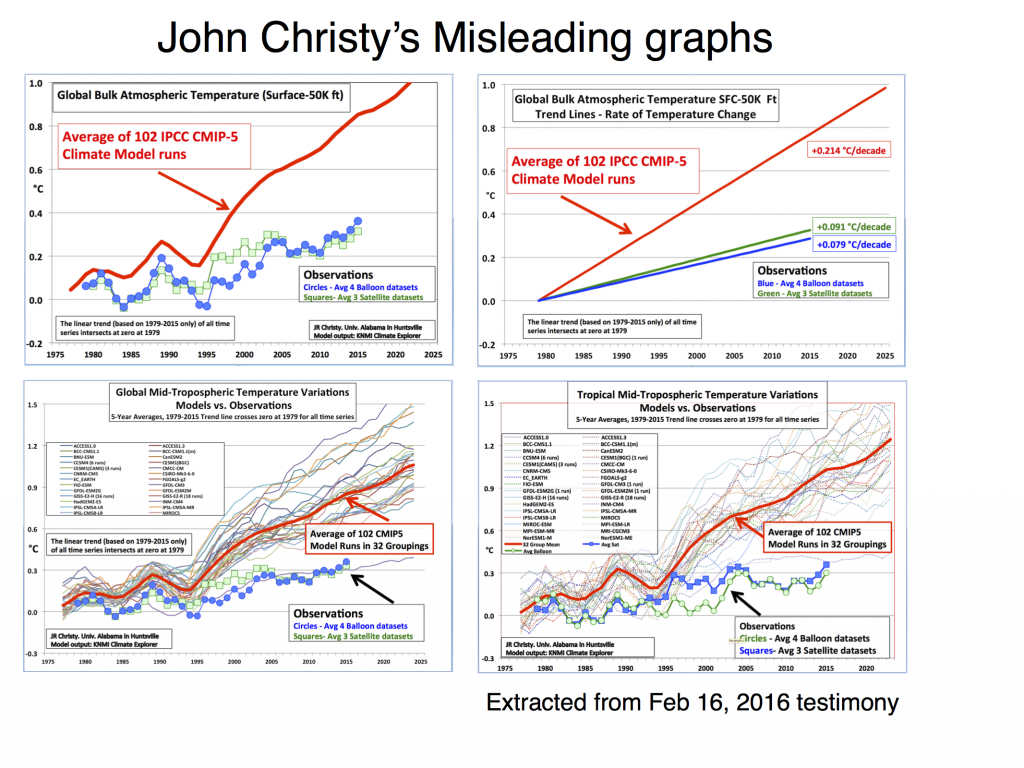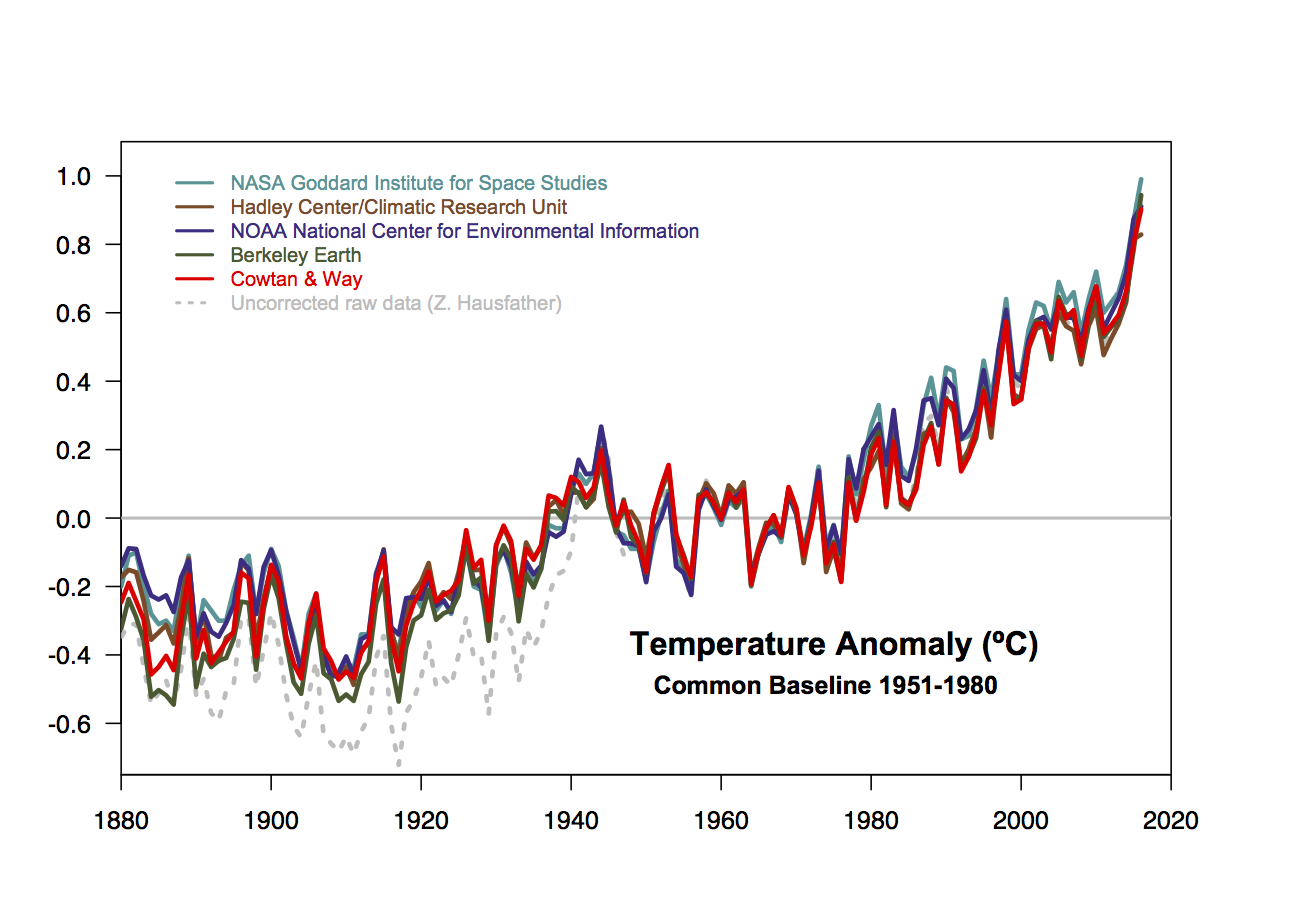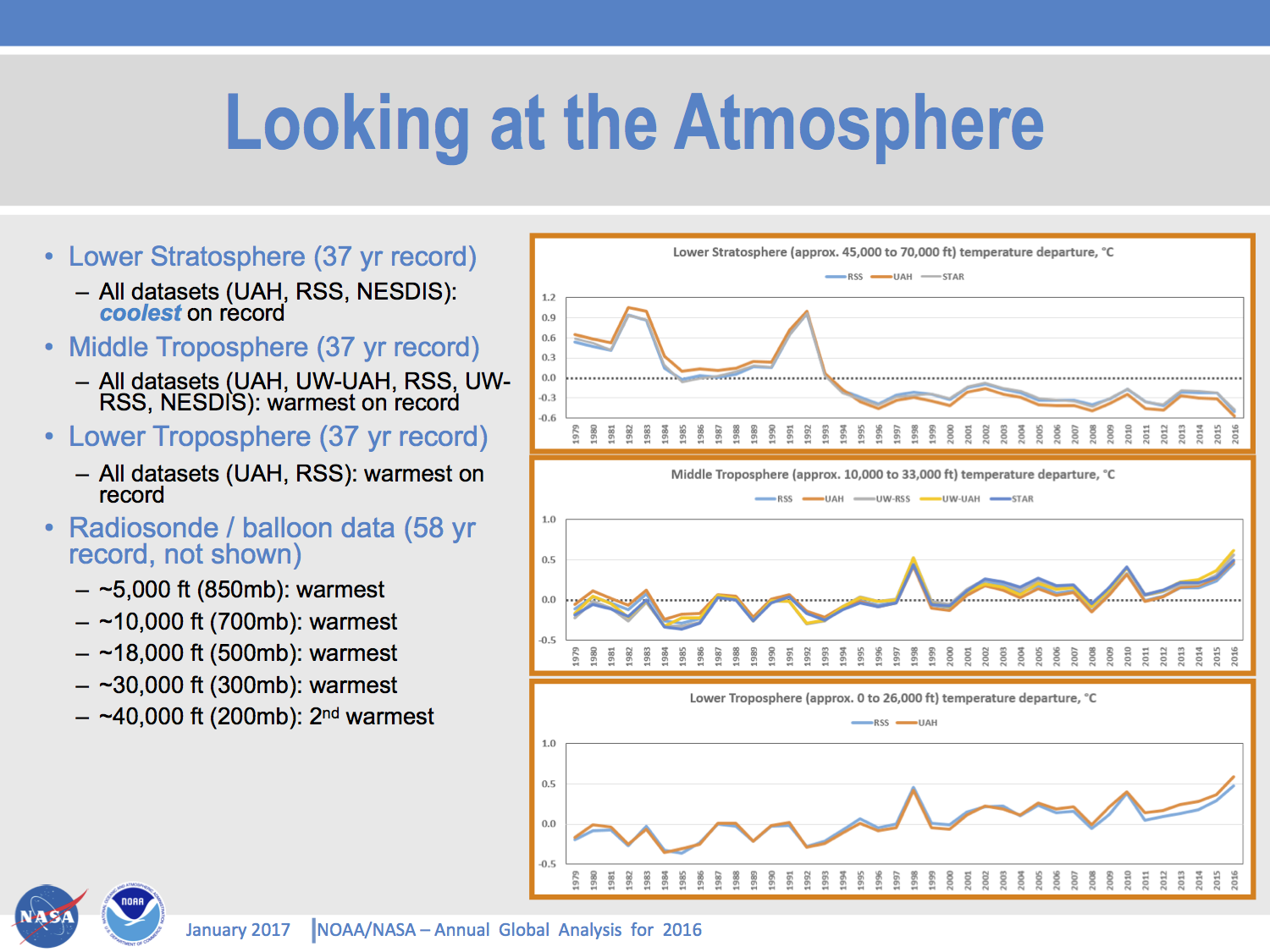This month’s open thread.
Blog – realclimate.org – All Posts
The true meaning of numbers
Gavin has already discussed John Christy’s misleading graph earlier in 2016, however, since the end of 2016, there has been a surge in interest in this graph in Norway amongst people who try to diminish the role of anthropogenic global warming.
I think this graph is warranted some extra comments in addition to Gavin’s points because it is flawed on more counts beyond those that he has already discussed. In fact, those using this graph to judge climate models reveal an elementary lack of understanding of climate data.

Something Harde to believe…
A commenter brings news of an obviously wrong paper that has just appeared in Global and Planetary Change. The paper purports to be a radical revision of our understanding of the carbon cycle by Hermann Harde. The key conclusions are (and reality in green):
- The average residence time of CO2 in the atmosphere is found to be 4 years.
[The residence time for an individual molecule is not the same as the perturbation response time of the carbon cycle which has timescales of decades to thousands of years.]
- The anthropogenic fraction of CO2 in the atmosphere is only 4.3%.
[Actually, it’s 30%.]
- Human emissions only contribute 15% to the CO2 increase over the Industrial Era.
[It’s all of it.]
Since these points contradict multiple independent sources of evidence, I can, without hesitation, predict that there are fundament flaws in this paper that will raise serious questions about the quality of the peer-review that this paper went through. Oddly, this paper is labeled as an “Invited Research Article” and so maybe some questions might be asked of the editor responsible too.
Notwithstanding our last post on the difficulty in getting comments published, this paper is crying out for one.
But this kind of thing has been done before, does not require any great sophistication or computer modeling to rebut, and has come up so many times before (Salby (also here), Beck, Segalstad, Jaworowski etc.), that perhaps a crowd-sourced rebuttal would be useful.
So, we’ll set up an overleaf.com page for this (a site for collaborative LaTeX projects), and anyone who wants to contribute should put the gist of their point in the comments and we’ll send the link so you can add it to the draft. Maybe the citizen scientists among you can pull together a rebuttal faster than the professionals?
Update: The crowd-sourced comment has appeared Köhler et al (2018).
References
- H. Harde, "Scrutinizing the carbon cycle and CO2 residence time in the atmosphere", Global and Planetary Change, vol. 152, pp. 19-26, 2017. http://dx.doi.org/10.1016/j.gloplacha.2017.02.009
- P. Köhler, J. Hauck, C. Völker, D.A. Wolf-Gladrow, M. Butzin, J.B. Halpern, K. Rice, and R.E. Zeebe, "Comment on “ Scrutinizing the carbon cycle and CO 2 residence time in the atmosphere ” by H. Harde", Global and Planetary Change, vol. 164, pp. 67-71, 2018. http://dx.doi.org/10.1016/j.gloplacha.2017.09.015
Someone C.A.R.E.S.
Do we need a new venue for post-publication comments and replications?
Social media is full of commentary (of varying degrees of seriousness) on the supposed replication crisis in science. Whether this is really a crisis, or just what is to be expected at the cutting edge is unclear (and may well depend on the topic and field). But one thing that is clear from all the discussion is that it’s much too hard to publish replications, or even non-replications, in the literature. Often these efforts have to be part of a new paper that has to make its own independent claim to novelty before it can get in the door and that means that most attempted replications don’t get published at all.
This is however just a subset of the difficulty that exists in getting any kind of comment on published articles accepted. Having been involved in many attempts – in the original journal or as a new paper – some successful, many not, it has become obvious to me that the effort to do so is wholly disproportionate to the benefits for the authors, and is thus very effectively discouraged.
The overall mismatch between the large costs/minimal benefit for the commenters, compared to the real benefits for the field, suggests that something really needs to change.
I have thought for a long time that an independent journal venue for comments would be a good idea, but a tweet by Katharine Hayhoe last weekend made me realize that the replication issue might be well served by a similar approach. So, here’s a proposal for a new journal.
Commentary And Replication in Earth Science (C.A.R.E.S.)
[Read more…] about Someone C.A.R.E.S.
References
- G. Foster, J.D. Annan, G.A. Schmidt, and M.E. Mann, "Comment on “Heat capacity, time constant, and sensitivity of Earth's climate system” by S. E. Schwartz", Journal of Geophysical Research: Atmospheres, vol. 113, 2008. http://dx.doi.org/10.1029/2007JD009373
- G.A. Schmidt, "Spurious correlations between recent warming and indices of local economic activity", International Journal of Climatology, vol. 29, pp. 2041-2048, 2009. http://dx.doi.org/10.1002/joc.1831
Serving up a NOAA-thing burger
I have mostly been sitting back and watching the John Bates story go through the predictable news-cycle of almost all supposed ‘scandalous’ science stories. The patterns are very familiar – an initial claim of imperfection spiced up with insinuations of misconduct, coordination with a breathless hyping of the initial claim with ridiculous supposed implications, some sensible responses refuting the initial specific claims and demolishing the wilder extrapolations. Unable to defend the nonsense clarifications are made that the initial claim wasn’t about misconduct but merely about ‘process’ (for who can argue against better processes?). Meanwhile the misconduct and data falsification claims escape into the wild, get more exaggerated and lose all connection to any actual substance. For sure, the technical rebuttals to the specific claims compete with balance of evidence arguments and a little bit of playful trolling for the attention of anyone who actually cares about the details. None of which, unfortunately, despite being far more accurate, have the narrative power of the original meme.
The next stages are easy to predict as well – the issues of ‘process’ will be lost in the noise, the fake overreaction will dominate the wider conversation and become an alternative fact to be regurgitated in twitter threads and blog comments for years, the originators of the issue may or may not walk back the many mis-statements they and others made but will lose credibility in any case, mainstream scientists will just see it as hyper-partisan noise and ignore it, no papers will be redacted, no science will change, and the actual point (one presumes) of the ‘process’ complaint (to encourage better archiving practices) gets set back because it’s associated with such obvious nonsense.
This has played out many, many times before: The Yamal story had a very similar dynamic, and before that the ‘1934‘ story, etc. etc.
Assuming for the sake of politeness that sound and fury signifying nothing is not the main goal for at least some participants, the question arises: since this is so predictable why do people still keep making the same mistakes?
Fake news, hacked mail, alternative facts – that’s old hat for climate scientists
Distortion? False information? Conspiracy theories? Hacked email? Climate scientists have known all this for decades. What can be learned from their rich experience with climate propaganda.
The world is slowly waking up. “Post-truth” was declared the word of the year 2016 by the Oxford Dictionaries. Finally, people start to widely appreciate how dangerous the epidemic of fake news is for democracy.
Stir up hate, destroy discourse, make insane claims until no one can distinguish the most bizarre absurdity from the truth any more.
Thus the Austrian author Robert Misik aptly describes the strategy of right-wing populists.
Some call it “alternative facts”. (Those are the convenient alternative to true facts.) Let’s simply call it propaganda. [Read more…] about Fake news, hacked mail, alternative facts – that’s old hat for climate scientists
New report: Climate change, impacts and vulnerability in Europe 2016
Another climate report is out – what’s new? Many of the previous reports have presented updated status on the climate and familiar topics such as temperature, precipitation, ice, snow, wind, and storm activities.
The latest report Climate change, impacts and vulnerability in Europe 2016 from the European Environment Agency (EEA) also includes an assessment of hail, a weather phenomenon that is often associated with lightening (a previous report from EASAC from 2013 also covers hail).
Usually, there has not been a lot of information about hail, but that is improving. Still, the jury is still out when it comes to hail and climate change:
Despite improvements in data availability, trends and projections of hail events are still uncertain.
[Read more…] about New report: Climate change, impacts and vulnerability in Europe 2016
Unforced Variations: Feb 2017
There was no pause
I think that the idea of a pause in the global warming has been a red herring ever since it was suggested, and we have commented on this several times here on RC: On how data gaps in some regions (eg. the Arctic) may explain an underestimation of the recent warming. We have also explained how natural oscillations may give the impression of a faux pause. Now, when we know the the global mean temperature for 2016, it’s even more obvious.
Easterling and Wehner (2009) explained that it is not surprising to see some brief periods with an apparent decrease in a temperature record that increases in jumps and spurts, and Foster and Rahmstorf (2012) showed in a later paper how temperature data from the most important observations show consistent global warming trends when known short-term influences such as El Niño Southern oscillation (ENSO), volcanic aerosols and solar variability are accounted for.
A recent paper by Hausfather et al. (2017) adds little new to our understanding, although it confirms that there has not been a recent “hiatus” in the global warming. However, if there are doubts about a physical condition, then further scientific research is our best option for establishing the facts. This is exactly what this recent study did.
The latest findings confirm the results of Karl et al. 2015 from the National Oceanic Atmospheric Administration (NOAA), which Gavin described in a previous post here on RC. The NOAA analysis received unusual attention because of the harassment it drew from the chair of the US House Science Committee and the subpoena demand for emails.
[Read more…] about There was no pause
References
- D.R. Easterling, and M.F. Wehner, "Is the climate warming or cooling?", Geophysical Research Letters, vol. 36, 2009. http://dx.doi.org/10.1029/2009GL037810
- G. Foster, and S. Rahmstorf, "Global temperature evolution 1979–2010", Environmental Research Letters, vol. 6, pp. 044022, 2011. http://dx.doi.org/10.1088/1748-9326/6/4/044022
- Z. Hausfather, K. Cowtan, D.C. Clarke, P. Jacobs, M. Richardson, and R. Rohde, "Assessing recent warming using instrumentally homogeneous sea surface temperature records", Science Advances, vol. 3, 2017. http://dx.doi.org/10.1126/sciadv.1601207
- T.R. Karl, A. Arguez, B. Huang, J.H. Lawrimore, J.R. McMahon, M.J. Menne, T.C. Peterson, R.S. Vose, and H. Zhang, "Possible artifacts of data biases in the recent global surface warming hiatus", Science, vol. 348, pp. 1469-1472, 2015. http://dx.doi.org/10.1126/science.aaa5632
2016 Temperature Records
To nobody’s surprise, all of the surface datasets showed 2016 to be the warmest year on record.

Barely more surprising is that all of the tropospheric satellite datasets and radiosonde data also have 2016 as the warmest year.

Coming as this does after the record warm 2015, and (slightly less definitively) record warm 2014, the three records in row might get you to sit up and pay attention.